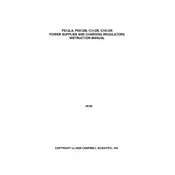Campbell Scientific CH12R Instruction Manual


To connect the CH12R Regulator to a solar panel, first ensure that the solar panel's voltage and current specifications are compatible with the regulator. Connect the positive and negative leads from the solar panel to the corresponding input terminals on the CH12R. Ensure all connections are secure to prevent any potential power loss or damage.
Mount the CH12R Regulator in a location that is protected from direct exposure to weather elements, ideally in an enclosure. Ensure there is adequate ventilation to prevent overheating. The regulator should be mounted vertically to facilitate natural convection cooling.
Check all connections for proper contact and ensure the solar panel is producing power. Measure the voltage at the regulator's input and output terminals to ensure it is within specified limits. Inspect the battery for any faults or issues, and verify that the regulator's settings match the battery type.
Regularly inspect the regulator for any signs of wear or damage. Clean any dust or debris from the unit's exterior. Check all electrical connections for corrosion or looseness, and ensure the cooling fins are not obstructed. Periodically test the system's performance to ensure efficient operation.
The CH12R Regulator is compatible with a variety of battery types, including lead-acid and lithium-ion. Make sure to configure the regulator settings to match the specific type of lithium-ion battery being used to ensure proper charging and safety.
To reset the CH12R Regulator to factory settings, consult the user manual for the specific reset procedure. Typically, this involves accessing the device's settings menu and selecting the reset option. Ensure all important data is backed up before performing a reset.
The CH12R Regulator is equipped with LED indicators that display the charging status, battery level, and any fault conditions. Refer to the user manual for a detailed explanation of each indicator's meaning and associated troubleshooting steps.
Install a surge protection device on the input side of the regulator to guard against overvoltage conditions. Ensure that the regulator's input voltage does not exceed its specified limits, and regularly monitor the system for any anomalies.
If the CH12R Regulator overheats, check for any obstructions to airflow and ensure it is mounted in a ventilated location. Reduce the load connected to the regulator and check for any issues with the solar panel or battery that might contribute to excessive heat.
While it is technically possible to daisy chain multiple CH12R Regulators, it is important to ensure that the combined system remains within the electrical specifications of each regulator. Consult the user manual for guidance on connecting multiple units in parallel or series configurations.